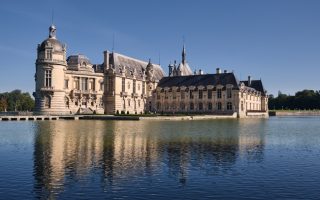Alpine Triangle

Peaks rise abruptly and starkly behind snug Alpine villages. A lowlander’s first sense is that the people here must have long huddled with their backs to these wild mountains, their faces turned hopefully to the valleys for comfort.
Nothing could be further from the truth, as the Alpine “friendship triangle” attests. Mont Dolent is the point where Italy and Switzerland meet, with the French border close by—it’s the heart and soul of the Mont Blanc massif. Le triangle de l’amitié is bounded by Martigny in Switzerland, Chamonix in France and Courmayeur/Aosta in Italy. The nickname says it all: emperors and kings come and go, national boundaries shift, but the montagnards here long ago accepted the peaks as the center of their universe, sharing the beauty and hard work they represent.
French, mixed with (mostly) mutually understandable patois has been the cross-border common language for centuries. Triangle villagers nurture wildlife—including the shy ibex (bouquetin), the wild mountain goat coaxed back from the brink of extinction—and they share a common approach to protecting their delicate environment, managing their winter sports industries, and working their craggy land, from creating sterling wines to breeding some of the feistiest cows on earth.
Climbers’ capital
Chamonix Mont-Blanc, in France’s Haute Savoie, is the home of modern mountaineering. In 1741 British travelers William Windham and Richard Pococke regaled London with tales of the amazing peaks and the mer de glace (sea of ice) they had “discovered”. In 1786 Michel Gabriel Paccard and Jacques Balmat made the first ascent of Mont Blanc, Europe’s highest peak at 15,780 feet. Ever since, the Mont Blanc massif has been a summer magnet for climbers, pickaxes and crampons in tow.
The history of climbing and the role of brave guides is foremost in this bustling town of 10,000, which also gears up in December to welcome crowds for the huge variety of winter sports on offer. The guides center—the famed Compagnie des Guides de Chamonix Mont-Blanc, created in 1821—is still the place to go if you are considering anything more than a day hike along one of the 16 miles of trails at lower altitude, for which the tourist office has good maps. Dangerous couloirs and the risk of avalanche make this no place for amateurs. A “glaciorium” at the Mer de Glace, opened last summer, is staffed by three glaciologists to answer questions about glaciers.
You’ll see mountain memorabilia at every turn on the main street that trundles alongside the river Arve. A recent wall mural depicts the history of climbing. At the popular chocolate shop Aux Petits Gourmands, the latest item is a specially molded, snowcapped mini-mountain. Farther along, the church in the square has two beautiful, modern stained glass windows showing skiers and sledders whizzing down the slopes.
Be sure to admire the casino, once a hotel where Napoleon III and Empress Eugénie stayed in 1860, when Savoie was ceded to France by the Kingdom of Sardinia. Visit the Arpin fabric shop, which continues to make the remarkable heavy materials used for clothing and even tents in those early Alpine climbing days. Today the sports crowd has turned to high-tech synthetics, but the shop does a thriving business providing haute-montagne upholstery for upmarket hotels and well-heeled chalet owners.
Ski if you’re there in season, climb if you’re tempted, but in any event get out into nature and hike, for nature is what this area is all about. If the snow is good, rent snowshoes. Take the cable car up to the Aiguille du Midi (the “southern needle”), where you’ll suddenly understand the magic pull of Mont Blanc. And if you’re not too tired after all that, you can note that Chamonix, as an international sports-lovers’ crossroads, has a lively nightlife.
Nearby Argentières is a haven for backpackers and wild snowboarders, thanks to Les Grands Montets’ high, ungroomed slopes for freeriders. The collegiate ambience is fun—beer and pizza replace the wine and fine cheeses of Chamonix. It’s a wonderful place for walking, and so is the Aiguilles Rouges nature reserve, down the road towards Martigny.
Vertigo vineyards
On the Swiss side of Mont Blanc, in the canton of Valais, the view of Martigny, the triangle’s only town on the plains, comes as an elegant surprise after the austerity of the Forclaz pass. The road suddenly turns into a series of dizzying downhill bends, following the old corkscrew Roman road to the broad Rhône valley. Drivers beware! The scenery is breathtaking, but the road is fast and confident local drivers require total attention.
On the way down, larch and pine abruptly give way to Martigny’s glorious vineyards, some of the steepest in Switzerland—a country noted for the centuries-old dry stone walls that hold terraced vines in place. The vineyards are small, production is limited, but Martigny’s award-winning wines are splendid, a secret little known except to connoisseurs. Gérard Besse’s vertigo-steep vineyards are in the hamlet of Les Rappes, where the spectacular view encompasses the length of the Rhône. Besse grows 14 varieties of grapes that produce wines marked by their mountain-stone terroir. Be sure to try his oaked Serpentine line, and ask about the fountain in the barrel storage room, sculpted from serpentine stone by André Rabond.
Another top winemaker here is Benoît Dorsaz, a pioneer in top-quality organic wines, with vines on the slopes of Fully, across the Rhône. I have fond memories of walking through the high terraces as Dorsaz showed me the perfumed wild thyme he was planting between the vines. One of the best wines to try is his Arvine.
The banks of the Rhône around Martigny are rich in fruit orchards and Morand, a distillery that specializes in fruit eaux-de-vie, is a much-loved local institution, open for visits from October to March.
Gods, saints and puppies
Beyond the wine and spirits, there’s much to see in Martigny. Octodurus, the original settlement of Celtic Gauls here, became the Roman town called Forum Claudii Vallensium, whose traces can still be seen in the ruins of the amphitheater and the Mithraeum, a temple dedicated to the god Mithra, a favorite of Roman legions. Superb bronzes and other Roman remnants are assembled in the Gallo-Roman museum of the Fondation Pierre Gianadda, which also houses the Franck Collection of 19th- and 20th-century art and an automobile museum, all in a contemporary building set in a delightful sculpture garden. The Fondation is renowned for its world-class art exhibits and is a wonderful place to hole up when the weather keeps you indoors.
Around the corner, the Musée et Chiens du Saint Bernard-Fondation Bernard et Caroline de Watteville is dedicated to the legendary dogs who were long used for mountain rescue until replaced by more contemporary means. In 2005, the monastery that bred the dogs for some 300 years ceded the breeding duties to the Fondation Barry; the newest litter, of ten puppies, was born on October 4. The kennel, just outside of town, is open to the public on weekends. The monastery, the Hospice du Grand Saint Bernard in the Grand Saint Bernard Pass, was founded in the 11th century by Saint Bernard de Menthon and is still there, run by a religious community and offering lodgings and meals for the general public, along with its own museum. In winter, when the pass is closed, it’s accessible only on foot, snowshoes or skis.
For cars, the alternative route into Italy is the Grand Saint Bernard tunnel, which is open year-round. But the entrance is at 4,900 feet, so be sure to check weather and traffic reports. Touring Club Suisse has a good smart phone app for road reports in English and the app’s maps are useful.
Paradise found
Bilingual Aosta is the doorway to Italy, and to the former royal hunting grounds that became the Parco Nazionale del Gran Paradiso, Italy’s first national park, in 1922. It was here that the last of the ibex lived, after the herds once found throughout the Alps had been hunted nearly to extinction by the early 19th century. But those here in their royal reserve survived, protected by the kings of Sardinia-Piedmont and later the kings of Italy, and gradually, starting in the early 20th century, they provided the stock that was re-introduced throughout the region.
Don’t miss a detour here to the lateral valley and quartet of hamlets collectively called Cogne, a half-hour drive from Aosta along the northern edge of the park. The small community can’t be built up because of its park location; as a result, it’s simply charming, and a haven for hikers, snowshoe fans and especially cross-country skiers addicted to peace and quiet.
With fewer than 1,000 residents, Cogne has nearly 40 hotels, almost all family-owned, and most of them offer good value for money. One standout is the Hotel Bellevue, overlooking the park and its peaks. Built in 1926, it’s known for its 38 cozy antique-filled rooms and superb restaurant. With its spa just enlarged for this winter season, and no hike in prices, the beautiful old hotel is one of the best deals around.
Cogne also has a surprising number of good restaurants. Favorites include Lou Bequet, with fine cuisine featuring regional products, and the popular, lively Brasserie Bon Bec.
Heroic wines
Heading back to the busier world from Cogne, you can’t miss the beautiful vineyards that dot the landscape from Aymavilles to Courmayeur. By now you’ll have noticed that place names appear to be French and that’s the language everyone speaks. French is taught from early childhood here and fluency is required, although Italian is the official language and the one most people hear on TV and radio.
Aymavilles’s vineyards, like Martigny’s, are often planted on impressive slopes that look like ibex territory. Young Didier Gerbelle is one of the new breed of energetic and creative winemakers experimenting with new grape varieties and testing native ones that have gone out of style; not yet 30, he is racking up awards. His wines, and those from the other sides of the peak are judged at a remarkable international wine competition held in Courmayeur for “vins héroïques”, grown under extreme conditions, including slopes of at least 30 degrees.
The autoroute is the fastest and easiest way to Courmayeur, which most people equate with chic skiing, luxury hotels and fine chalets. Take the slower, older road and you’ll go through villages with Italian bakeries and artisanal craftsmen who make mountain-style dried beef and the region’s signature Fontina cheese. Take a minute to ask about the pastures for the dairy cows and you’ll learn that the cheese from June and July milk smells of Alpine flowers, but with cheese from another pasture, another month, you’ll detect the lush aroma of grasses and grains.
The region is home to short-legged black Val d’Hérens cows, whose milk is used for raclette, the mountain cheese that is eaten melted with potatoes and pickles. The Val d’Hérens are also the famous Valais fighting cows: in spring the pregnant females fight among themselves to establish the herd’s hierarchy—the winners are the strongest and smartest, who will lead the others to the best grazing. The cows fight naturally in the fields, but competitions are also now staged in arenas, and thousands of visitors come to watch.
Winter makes you appreciate the hardiness, the warmth and spirit of the triangle de l’amitié. It also makes you long to return when the snow is just a memory, the cows are out on the high pastures and the meadows running down to Martigny from the Grand Saint Bernard are gorgeously in bloom.
LOOPING THE TRIANGLE
The distances are surprisingly short— driving straight through, the triangle could be looped in less than four hours:
Martigny to Chamonix: about 45 minutes via the Forclaz pass (4,920 ft)
Chamonix to Courmayeur: 25 minutes via the 7-mile Mont Blanc tunnel
Courmayeur to Aosta: 40 minutes on the new autoroute or an hour on the old road
Aosta to Martigny: about 75 minutes via the 3.6-mile Grand Saint Bernard tunnel
ALPINE TRIANGLE NOTEBOOK
Tourist Offices Chamonix www. chamonix.com; Val d’Aosta (Courmayeur, Cogne) www.lovevda.it/turismo; Martigny www.martigny.com
Saint Bernard Museum www.museesaintbernard.ch
Barry Foundation Kennel www.fondation-barry.ch
Hospice du Grand-Saint-Bernard www.gsbernard.net
Fondation Gianadda www.gianadda.ch
HOTELS
Jardin de Kabîr Only three rooms at this charming architectural gem of a B&B in the sometimes dull-looking city center. 19 rue du Bourg, Martigny. +41.27.722.0308. www.jardindekabir.ch
Le Hameau Albert 1er Luxury, great location and superb two-star restaurant. 38 route du Bouchet, Chamonix Mont-Blanc. 04.50.53.05.09. www.hameaualbert.fr
Auberge de La Maison Elegant, cozy chalet hotel with 38 rooms and a spectacular dining-room view. Spa. Entrèves, Courmayeur. +39.01.65.86.98.11. www.aubergemaison.it
Hotel Bellevue Difficult to find a more delightful spot, with cozy bedrooms, fireplaces, a new spa and a two-star restaurant with superb cuisine and great wine. 22 rue du Grand Paradis, Cogne. +39.01.65.74.825. www.hotelbellevue.it
RESTAURANTS
Lou Bequet Famed for local cuisine and seasonal products, all prepared with finesse. Good value. 93 Via Fraz. Cretaz, Cogne. +39.01.65.74.651 www.loubequet.it
Pierre Alexis 1877 Good food and people-watching. (Many Italians skip the actual ski slopes.) 50 via G. Marconi, Courmayeur. +39.01.65.84.35.17
Cadran Solaire More good food and people-watching. 122 via Roma, Courmayeur. +39.01.65.84.46.09
La Piazzetta Seafood pastas and good Italian pizza. 13/a via Roma, Courmayeur. +39.0165.84.41.50 www.ristorantelapiazzetta.info
Le Bistrot One-star restaurant in the Hôtel Morgane, at the foot of the Aiguille du Midi ski lift, popular with local residents. Affordable prices. 151 ave de l’Aiguille du Midi, Chamonix. 04.50.53.57.64 www.lebistrotchamonix.com
Le Belvédère Perched above town, delightful view, exquisite meals. One two-bedroom suite, one apartment with kitchen. 1 Route de Chemin, Chemin (near Martigny). +41.27.723.1400 www.lebelvedere.ch
Les 3 Couronnes In a 17th-century house, a favorite gourmet haunt for local residents. Fine dining, great wine list. Lunch specials are shorter and very affordable. 8 pl du Bourg, Martigny. +41.27.723.2114 www.les3couronnes.ch
Originally published in the December 2012 issue of France Today
Share to: Facebook Twitter LinkedIn Email
Leave a reply
Your email address will not be published. Required fields are marked *



